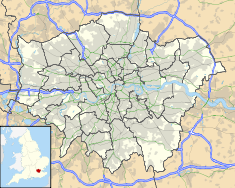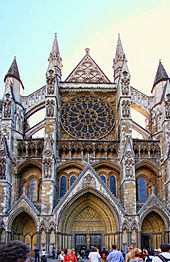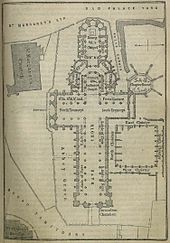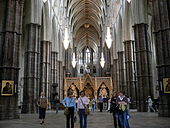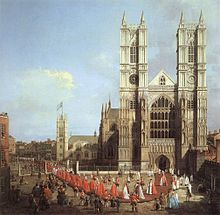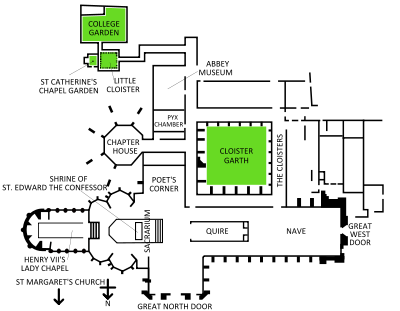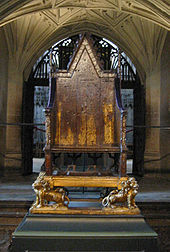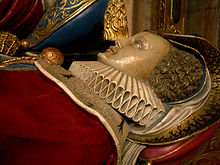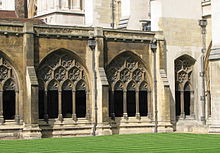- Westminster Abbey
-
For other uses, see Westminster Abbey (disambiguation).
Westminster Abbey The Abbey's western façadeLocation: City of Westminster, London, UK Coordinates: 51°29′58″N 00°07′39″W / 51.49944°N 0.1275°WCoordinates: 51°29′58″N 00°07′39″W / 51.49944°N 0.1275°W Architectural style(s): Gothic UNESCO World Heritage Site Official name: Westminster Palace, Westminster Abbey and Saint Margaret's Church Type: Cultural Criteria: i, ii, iv Designated: 1987 (11th session) Reference #: 426 Country: United Kingdom Region: Europe and North America Listed Building – Grade I Official name: Westminster Abbey (The Collegiate Church of St Peter) Designated: 24-Feb-1958 Reference #: 1291494[1] The Collegiate Church of St Peter at Westminster, popularly known as Westminster Abbey, is a large, mainly Gothic church, in the City of Westminster, London, United Kingdom, located just to the west of the Palace of Westminster. It is the traditional place of coronation and burial site for English, later British and later still (and currently) monarchs of the Commonwealth realms. The abbey is a Royal Peculiar and briefly held the status of a cathedral from 1540 to 1550.
Westminster Abbey is a collegiate church governed by the Dean and Chapter of Westminster, as established by Royal charter of Queen Elizabeth I in 1560, which created it as the Collegiate Church of St Peter Westminster and a Royal Peculiar under the personal jurisdiction of the Sovereign. The members of the Chapter are the Dean and four residentiary Canons, assisted by the Receiver General and Chapter Clerk. One of the Canons is also Rector of St Margaret's Church, Westminster, and often holds also the post of Chaplain to the Speaker of the House of Commons. In addition to the Dean and Canons, there are at present two full-time minor canons, one precentor, the other succentor. The office of Priest Vicar was created in the 1970s for those who assist the minor canons. Together with the Clergy and Receiver General and Chapter Clerk, various Lay Officers constitute the College, including the Organist and Master of the Choristers, the Registrar, the Auditor, the Legal Secretary, the Surveyor of the Fabric, the Head Master of the Choir School, the Keeper of the Muniments and the Clerk of the Works, as well as twelve Lay Vicars and ten of the choristers and the High Steward and High Bailiff. There are also forty Queen's Scholars who are pupils at Westminster School (the School has its own Governing Body). Those who are most directly concerned with liturgical and ceremonial matters are the two Minor Canons and the Organist and Master of the Choristers.
Contents
History
According to a tradition first reported by Sulcard in about 1080, the Abbey was first founded in the time of Mellitus (d. 624), Bishop of London, on the present site, then known as Thorn Ey (Thorn Island); based on a late tradition that a fisherman called Aldrich on the River Thames saw a vision of Saint Peter near the site. This seems to be quoted to justify the gifts of salmon from Thames fishermen that the Abbey received in later years. In the present era, the Fishmonger's Company still gives a salmon every year. The proven origins are that in the 960s or early 970s, Saint Dunstan, assisted by King Edgar, installed a community of Benedictine monks here.
Between 1042 and 1052 King Edward the Confessor began rebuilding St Peter's Abbey in order to provide himself with a royal burial church. It was the first church in England built in the Norman Romanesque style. It was not completed until around 1090 but was consecrated on 28 December 1065, only a week before the Confessor's death on 5 January 1066.[2] The next day he was buried in the church, and nine years later his wife Edith was buried alongside him.[3] His successor, Harold II, was probably crowned in the Abbey, although the first documented coronation is that of William the Conqueror later the same year.[4]
The only extant depiction of Edward's abbey, together with the adjacent Palace of Westminster, is in the Bayeux Tapestry. Increased endowments supported a community increased from a dozen monks in Dunstan's original foundation, to about eighty monks.[5] Construction of the present church was begun in 1245 by Henry III[6] who had selected the site for his burial.
The abbot and learned monks, in close proximity to the royal Palace of Westminster, the seat of government from the later twelfth century, became a powerful force in the centuries after the Norman Conquest: the abbot often was employed on royal service and in due course took his place in the House of Lords as of right. Released from the burdens of spiritual leadership, which passed to the reformed Cluniac movement after the mid-tenth century, and occupied with the administration of great landed properties, some of which lay far from Westminster, "the Benedictines achieved a remarkable degree of identification with the secular life of their times, and particularly with upper-class life", Barbara Harvey concludes, to the extent that her depiction of daily life[7] provides a wider view of the concerns of the English gentry in the High and Late Middle Ages. The proximity of the Palace of Westminster did not extend to providing monks or abbots with high royal connections; in social origin the Benedictines of Westminster were as modest as most of the order. The abbot remained Lord of the Manor of Westminster as a town of two to three thousand persons grew around it: as a consumer and employer on a grand scale the monastery helped fuel the town economy, and relations with the town remained unusually cordial, but no enfranchising charter was issued during the Middle Ages.[8] The Abbey built shops and dwellings on the west side, encroaching upon the sanctuary.
The Abbey became the coronation site of Norman kings, but none were buried there until Henry III, intensely devoted to the cult of the Confessor, rebuilt the Abbey in Anglo-French Gothic style as a shrine to honour Saint Edward the Confessor and as a suitably regal setting for Henry's own tomb, under the highest Gothic nave in England. The Confessor's shrine subsequently played a great part in his canonisation. The work continued between 1245 and 1517 and was largely finished by the architect Henry Yevele in the reign of Richard II. Henry VII added a Perpendicular style chapel dedicated to the Blessed Virgin Mary in 1503 (known as the Henry VII Chapel). Much of the stone came from Caen, in France (Caen stone), the Isle of Portland (Portland stone) and the Loire Valley region of France (tuffeau limestone).
In 1535, the Abbey's annual income of £2400–2800[citation needed] (£980,000 to £1,140,000 as of 2011),[9] during the assessment attendant on the Dissolution of the Monasteries rendered it second in wealth only to Glastonbury Abbey. Henry VIII had assumed direct royal control in 1539 and granted the Abbey cathedral status by charter in 1540, simultaneously issuing letters patent establishing the Diocese of Westminster. By granting the Abbey cathedral status Henry VIII gained an excuse to spare it from the destruction or dissolution which he inflicted on most English abbeys during this period. Westminster was a cathedral only until 1550. The expression "robbing Peter to pay Paul" may arise from this period when money meant for the Abbey, which is dedicated to Saint Peter, was diverted to the treasury of St Paul's Cathedral.
The Abbey was restored to the Benedictines under the Catholic Mary I of England, but they were again ejected under Elizabeth I in 1559. In 1579, Elizabeth re-established Westminster as a "Royal Peculiar"—a church responsible directly to the Sovereign, rather than to a diocesan bishop—and made it the Collegiate Church of St Peter (that is, a church with an attached chapter of canons, headed by a dean). The last Abbot was made the first Dean. It suffered damage during the turbulent 1640s, when it was attacked by Puritan iconoclasts, but was again protected by its close ties to the state during the Commonwealth period. Oliver Cromwell was given an elaborate funeral there in 1658, only to be disinterred in January 1661 and posthumously hanged from a nearby gibbet.
The Abbey's two western towers were built between 1722 and 1745 by Nicholas Hawksmoor, constructed from Portland stone to an early example of a Gothic Revival design. Purbeck marble was used for the walls and the floors of Westminster Abbey, even though the various tombstones are made of different types of marble. Further rebuilding and restoration occurred in the 19th century under Sir George Gilbert Scott. A narthex (a portico or entrance hall) for the west front was designed by Sir Edwin Lutyens in the mid 20th century but was not executed. Images of the Abbey prior to the construction of the towers are scarce, though the Abbey's official website states that the building was without towers following Yevele's renovation, with just the lower segments beneath the roof level of the Nave completed.
Until the 19th century, Westminster was the third seat of learning in England, after Oxford and Cambridge. It was here that the first third of the King James Bible Old Testament and the last half of the New Testament were translated. The New English Bible was also put together here in the 20th century. Westminster suffered minor damage during the Blitz on 15 November 1940.
In the 1990s two icons by Russian icon painter Sergei Fyodorov were hung in the Abbey.[10] On 6 September 1997 the funeral of Diana, Princess of Wales was held at the Abbey. On 17 September 2010 Pope Benedict XVI became the first pope to set foot in the Abbey.[11]
 Flag of Westminster Abbey, featuring the Tudor arms between Tudor Roses above the supposed arms of Edward the Confessor
Flag of Westminster Abbey, featuring the Tudor arms between Tudor Roses above the supposed arms of Edward the Confessor
Coronations
Since the coronations in 1066 of both King Harold and William the Conqueror, coronations of English and British monarchs were held in the Abbey.[12][13] Henry III was unable to be crowned in London when he first came to the throne because the French prince Louis had taken control of the city, and so the king was crowned in Gloucester Cathedral. However, this coronation was deemed by the Pope to be improper, and a further coronation was held in the Abbey on 17 May 1220.[14] The Archbishop of Canterbury is the traditional cleric in the coronation ceremony.
King Edward's Chair (or St Edward's Chair), the throne on which English and British sovereigns have been seated at the moment of coronation, is housed within the Abbey and has been used at every coronation since 1308. From 1301 to 1996 (except for a short time in 1950 when it was temporarily stolen by Scottish nationalists), the chair also housed the Stone of Scone upon which the kings of Scots are crowned. Although the Stone is now kept in Scotland, in Edinburgh Castle, at future coronations it is intended that the Stone will be returned briefly to St Edward's Chair for the moment of coronation.
Royal weddings
Since 1100, there have been at least 16 royal weddings at Westminster Abbey. Only two were weddings of reigning monarchs (Henry I and Richard II), and there were none at all for more than five centuries between 1382 and 1919.[15]
Chronology
- 11 November 1100: King Henry I of England was married to Matilda of Scotland
- 4 January 1243: Richard, Earl of Cornwall (later King of Germany), brother of King Henry III of England, to Sanchia of Provence (his second wife). Sanchia was sister of Eleanor of Provence, Henry III’s queen.
- 9 April 1269: Edmund of Crouchback, 1st Earl of Leicester and Lancaster, son of King Henry III was married to Lady Aveline de Forz
- 30 April 1290: Joan of Acre, daughter of King Edward I was married to the 7th Earl of Gloucester
- 8 July 1290: Margaret of England, daughter of King Edward I was married to John II, son of Duke of Brabant
- 20 January 1382: King Richard II of England was married to Anne of Bohemia
- 27 February 1919: Princess Patricia of Connaught was married to Capt the Hon Alexander Ramsay
- 28 February 1922: The Princess Mary, daughter of King George V was married to Viscount Lascelles
- 26 April 1923: The Prince Albert, Duke of York (later King George VI), second son of King George V was married to Lady Elizabeth Bowes-Lyon (later to become Queen Elizabeth The Queen Mother)
- 29 November 1934: The Prince George, Duke of Kent, son of King George V was married to Princess Marina of Greece and Denmark
- 20 November 1947: The Princess Elizabeth (now Queen Elizabeth II), elder daughter of King George VI was married to The Duke of Edinburgh (who was Lt Philip Mountbatten until that morning)
- 6 May 1960: The Princess Margaret, second daughter of King George VI was married to Antony Armstrong-Jones (later Earl of Snowdon)
- 24 April 1963: Princess Alexandra of Kent was married to the Hon Angus Ogilvy
- 14 November 1973: The Princess Anne, only daughter of Elizabeth II was married to Captain Mark Phillips
- 23 July 1986: The Prince Andrew, Duke of York, second son of Elizabeth II, was married to Miss Sarah Ferguson
- 29 April 2011: Prince William, Duke of Cambridge, grandson of Elizabeth II was married to Miss Catherine Middleton
Burials and memorials
Main article: Westminster Abbey Burials and MemorialsHenry III rebuilt the Abbey in honour of the Royal Saint Edward the Confessor whose relics were placed in a shrine in the sanctuary. Henry III himself was interred nearby, as were many of the Plantagenet kings of England, their wives and other relatives. Until the death of George II in 1760, most Kings and Queens were buried in the Abbey, two notable exceptions being Henry VIII and Charles I who are buried in St George's Chapel at Windsor Castle. Most monarchs and royals who died after 1760 are buried at Frogmore to the east of Windsor Castle.
Since the Middle Ages, aristocrats were buried inside chapels and monks and people associated with the Abbey were buried in the Cloisters and other areas. One of these was Geoffrey Chaucer, who was buried here as he had apartments in the Abbey where he was employed as master of the King's Works. Other poets, writers and musicians were buried or memorialised around Chaucer in what became known as Poets' Corner. Abbey musicians such as Henry Purcell were also buried in their place of work.
Subsequently, it became one of Britain's most significant honours to be buried or commemorated here.[16] The practice of burying national figures in the Abbey began under Oliver Cromwell with the burial of Admiral Robert Blake in 1657.[17] The practice spread to include generals, admirals, politicians, doctors and scientists such as Isaac Newton, buried on 4 April 1727, and Charles Darwin, buried 19 April 1882.
During the early 20th century it became increasingly common to bury cremated remains rather than coffins in the Abbey. In 1905 the actor Sir Henry Irving was cremated and his ashes buried in Westminster Abbey, thereby becoming the first person ever to be cremated prior to interment at the Abbey.[18] Since 1936, no individual has been buried in a coffin in Westminster Abbey or its cloisters; the only exceptions to this rule are the Dukes of Northumberland, who own a private vault in the Abbey.
Just inside the great west door, in the centre of the nave, in the floor is the tomb of The Unknown Warrior, an unidentified British soldier killed on a European battlefield during the First World War. He was buried in Westminster Abbey, on 11 November 1920. There are many graves on the floors of the abbey but this is the only grave which is forbidden to step on.
In 1998 ten vacant statue niches at the West Gate were filled with 10 representative 20th Century martyrs.
Schools
Westminster School and Westminster Abbey Choir School are also in the precincts of the Abbey. It was natural for the learned and literate monks to be entrusted with education, and Benedictine monks were required by the Pope to maintain a charity school in 1179.
Organ
See also: List of Westminster Abbey organistsThe organ was built by Harrison & Harrison in 1937, then with four manuals and 84 speaking stops, and was used for the first time at the coronation of King George VI. Some pipework from the previous Hill organ of 1848 was revoiced and incorporated in the new scheme. The two organ cases, designed in the late nineteenth century by John Loughborough Pearson, were re-instated and coloured in 1959. In 1982 and 1987, Harrison and Harrison enlarged the organ under the direction of the then Abbey Organist Simon Preston to include an additional Lower Choir Organ and a Bombarde Organ: the current instrument now has five manuals and 109 speaking stops. In 2006, the console of the organ was refurbished by Harrison and Harrison, and space was prepared for two additional 16 ft stops on the Lower Choir Organ and the Bombarde Organ.[19]
The current Organist and Master of the Choristers is James O'Donnell.
Bells
The bells at the Abbey were overhauled in 1971. The ring is now made up of ten bells, hung for change ringing, cast in 1971, by the Whitechapel Bell Foundry, tuned to the notes: F#, E, D, C#, B, A, G, F#, E and D. The Tenor bell in D (588.5 Hz) has a weight of 30 cwt, 1 qtr, 15 lb (3403 lb or 1544 kg). In addition there are two service bells, cast by Robert Mot, in 1585 and 1598 respectively, a Sanctus bell cast in 1738 by Richard Phelps and Thomas Lester and two unused bells—one cast circa 1320, by the successor to R de Wymbish, and a second cast in 1742, by Thomas Lester.[20] The two service bells and the 1320 bell, along with a fourth small silver "dish bell", kept in the refectory, have been noted as being of historical importance by the Church Buildings Council of the Church of England.[21]
Transport
London Underground St James's Park
WestminsterLondon River Services Westminster Millennium Pier 
Chapter
The Chapter house was built concurrently with the east parts of the abbey under Henry III, between about 1245 and 1253. It was restored by Sir George Gilbert Scott in 1872. The entrance is approached from the east cloister walk and includes a double doorway with a large tympanum above. Inner and outer vestibules lead to the octagonal chapter house, which is of exceptional architectural purity. It is built in a Geometrical Gothic style with an octagonal crypt below. A pier of eight shafts carries the vaulted ceiling. To the sides are blind arcading, remains of 14th-century paintings and numerous stone benches above which are innovatory large 4-light quatre-foiled windows. These are virtually contemporary with the Sainte-Chapelle, Paris. The chapter house has an original mid-13th century tiled pavement. A door within the vestibule dates from around 1050 and is believed to be the oldest in England. The exterior includes flying buttresses added in the 14th century and a leaded tent-lantern roof on an iron frame designed by Scott. The Chapter house was originally used in the 13th century by Benedictine monks for daily meetings. It later became a meeting place of the King's Great Council and the Commons, predecessors of Parliament.
The Pyx Chamber formed the undercroft of the monks' dormitory. It dates to the late 11th century and was used as a monastic and royal treasury. The outer walls and circular piers are of 11th-century date, several of the capitals were enriched in the 12th century and the stone altar added in the 13th century. The term 'pyx' refers to the boxwood chest in which coins were held and presented to a jury during the Trial of the Pyx, in which newly-minted coins were presented to ensure they conformed to the required standards.
The Chapter house and Pyx Chamber at Westminster Abbey are in the guardianship of English Heritage, but under the care and management of the Dean and Chapter of Westminster. During the last year, English Heritage have funded a major programme of work on the Chapter, comprising repairs to the roof, gutters, stonework on the elevations and flying buttresses, and repairs to the lead light.
Museum
The Westminster Abbey Museum is located in the 11th-century vaulted undercroft beneath the former monks' dormitory in Westminster Abbey. This is one of the oldest areas of the Abbey, dating back almost to the foundation of the Norman church by Edward the Confessor in 1065. This space has been used as a museum since 1908.[22]
Exhibits
The exhibits include a unique collection of royal and other funeral effigies (funeral saddle, helm and shield of Henry V), together with other treasures, including some panels of mediaeval glass, 12th-century sculpture fragments, Mary II's coronation chair and replicas of the coronation regalia, and historic effigies of Edward III, Henry VII and his queen, Elizabeth I, Charles II, William III, Mary II and Queen Anne.
Later wax effigies include a striking likeness of Horatio, Viscount Nelson, wearing some of his own clothes and another of Prime Minister William Pitt, Earl of Chatham, modelled by the American-born sculptor Patience Wright.[citation needed] During recent conservation of Elizabeth I's effigy, a unique corset dating from 1603 was found on the figure and is now displayed separately.[citation needed]
A recent addition to the display is the late 13th-century Westminster Retable, England's oldest altarpiece. It was most probably designed for the High Altar of the Abbey, although it has been damaged in past centuries. The panel has been expertly cleaned and conserved.
Development plans
In June 2009 the first major building work at the Abbey for 250 years was proposed. A corona—a crown-like architectural feature—was intended to be built around the lantern over the central crossing, replacing an existing pyramidal structure dating from the 1950s. This was part of a wider £23m development of the Abbey expected to be completed in 2013.[23][24] On 4 August 2010 the Dean and Chapter announced that, "[a]fter a considerable amount of preliminary and exploratory work", efforts toward the construction of a corona would not be continued.[25]
Gallery
-
A view from the nearby London Eye to the North East
-
At night, from Dean's Yard to the South; artificial light highlights the flying buttresses
-
Four of the ten Christian martyrs depicted in statues above the Great West Door
-
The tomb of King Henry III of England.
-
The cloisters of Westminster Abbey looking South West towards Victoria Tower.
-
The west front of Westminster Abbey, with Victoria Tower visible to the East.
See also
- Abbot of Westminster
- Dean and Canons of Westminster
- List of churches in London
- List of Deans of Westminster
- The Abbey, a 1995 BBC TV documentary film
- The Unknown Warrior
- Westminster Abbey Burials and Memorials
Notes
- ^ "The National Heritage List For England". English Heritage. http://list.english-heritage.org.uk/. Retrieved 2011-07-31.
- ^ Eric Fernie, in Mortimer ed., Edward the Confessor, pp. 139–143
- ^ Pauline Stafford, 'Edith, Edward's Wife and Queen', in Mortimer ed., Edward the Confessor, p. 137
- ^ Westminster Abbey, Coronations
- ^ Harvey 1993, p. 2
- ^ History – Westminster Abbey, Retrieved 29 April 2011
- ^ Harvey 1993
- ^ Harvey 1993, p. 6 ff.
- ^ UK CPI inflation numbers based on data available from Lawrence H. Officer (2010) "What Were the UK Earnings and Prices Then?" MeasuringWorth.
- ^ "John Windsor'S Guide To Collecting Contemporary Art: Sergei Fyodorov At". The Independent (UK). 10 November 1998. http://www.independent.co.uk/arts-entertainment/the-independent-collector-john-windsors-guide-to-collecting-contemporary-art-sergei-fyodorov-1183976.html. Retrieved 28 April 2011.
- ^ Schjonberg, Mary Frances (17 September 2010). "Benedict becomes first pope to visit Lambeth, Westminster Abbey". Episcopal Life Online. http://www.episcopalchurch.org/81808_124609_ENG_HTM.htm. Retrieved 17 September 2010.
- ^ "History". Dean and Chapter of Westminster Abbey. http://www.westminster-abbey.org/our-history. Retrieved 19 April 2008.
- ^ "Coronations". Dean and Chapter of Westminster Abbey. http://www.westminster-abbey.org/our-history/royals/coronations. Retrieved 19 April 2008.Westminster-abbey.org
- ^ "Henry III, Archonotology.org". http://www.archontology.org/nations/england/king_england/henry3.php. Retrieved 21 April 2008.
- ^ "Royal Weddings at Westminster Abbey". Westminster Abbey. http://www.westminster-abbey.org/our-history/royals/weddings. Retrieved 29 April 2011.
- ^ Dunton, Larkin (1896). The World and Its People. Silver, Burdett. p. 26.
- ^ Westminster Abbey Mrs. A. Murray Smith, published 30 August 1904
- ^ "Woking Crematorium". Internet. The Cremation Society of Great Britain. http://www.srgw.demon.co.uk/CremSoc/History/HistSocy.html. Retrieved 28 November 2010.
- ^ N00646
- ^ Westminster—Collegiate Church of S Peter (Westminster Abbey), Dove's Guide for Church Bell Ringers, 25 October 2006. Retrieved on 16 October 2008.
- ^ "Database of Historically Significant Bells and Bell Frames". Churchcare website. Church of England. 1 April 2008. http://www.churchcare.co.uk/bells.php. Retrieved 16 October 2008. "search on "Westminster Abbey" for bell details"
- ^ Trowles 2008, p. 156
- ^ "Building work announced for Abbey", BBC News. Retrieved on 29 June 2009
- ^ Dean lines up new crown shaped roof for Westminster Abbey—Queen and The Prince of Wales kept abreast of £10m project to revamp historic church in time for diamond jubilee, The Guardian, 29 June 2009. Retrieved on 29 June 2009.
- ^ "Abbey Development Plan Update". Westminster Abbey. 4 August 2010. http://www.westminster-abbey.org/press/news/news/2010/august/abbey-development-plan-update. Retrieved 7 September 2010.
References
- Bradley, S. and N. Pevsner (2003) The Buildings of England – London 6: Westminster, New Haven: Yale University Press, pp. 105–207. ISBN 0-300-09595-3
- Mortimer, Richard ed., Edward the Confessor: The Man and the Legend, The Boydell Press, 2009. Eric Fernie, 'Edward the Confessor's Westminster Abbey', pp. 139–150. Warwick Rodwell, 'New Glimpses of Edward the Confessor's Abbey at Westminster', pp. 151–167. Richard Gem, Craftsmen and Administrators in the Building of the Confessor's Abbey', pp. 168–172. ISBN 978-1-84383-436-6
- Harvey, B. (1993) Living and Dying in England 1100–1540: The Monastic Experience, Ford Lecture series, Oxford: Clarendon Press. ISBN 0-19-820161-3
- Morton, H. V. [1951] (1988) In Search of London, London: Methuen. ISBN 0-413-18470-6
- Trowles, T. (2008) Treasures of Westminster Abbey, London: Scala. ISBN 978-1-85759-454-6
External links
Listen to this article (info/dl)
This audio file was created from a revision of Westminster Abbey dated 2005-04-21, and does not reflect subsequent edits to the article. (Audio help)More spoken articles- Official site
- Walter Thornbury, Old and New London, Volume 3, 1878, pp. 394–462, British History Online
- Historic images of Westminster Abbey
- Westminster Abbey: A Peek Inside – slideshow by Life magazine
- Keith Short – Sculptor Images of stone carving for Westminster Abbey
- Westminster Abbey Listens to Violinist
- Carved Crests for the Knights of the Bath
- A history of the choristers and choir school of Westminster Abbey
- Catholic Encyclopedia: Westminster Abbey
- Adrian Fletcher’s Paradoxplace Westminster Abbey Pages—Photos
- A panorama of Westminster Abbey in daytime – JPEG and 3D Quicktime versions
- Westminster Abbey on Twitter
- Audio Guide of Westminster Abbey
Benedictine abbeys and priories in medieval England and Wales Independent houses Abergavenny · Abbotsbury · Abingdon · Alcester · Athelney · Bardney · Bath · Battle · Bedford · Birkenhead · Bradwell · Buckfast · Burton · Bury St Edmunds · Canterbury (Christ Church) · Canterbury (St Augustine's) · Canwell · Cerne · Chertsey · Chester · Cholsey · Colchester · Coventry · Crowland · Durham · Ely · Evesham · Eynsham · Faversham · Glastonbury · Gloucester · Humberston · Luffield · Malmesbury · Milton · Monk Bretton · Muchelney · Mullicourt · Norwich (Holy Trinity) · Pershore · Peterborough · Ramsey · Reading · Rochester · St Albans · St Benet of Hulme · Sandwell · Selby · Sherborne · Shrewsbury · Snelshall · Tavistock · Tewkesbury · Thorney · Upholland · Walden · Westminster · Whitby · Winchcombe · Winchester (New Minister) · Winchester (St Swithun) · Worcester · York (St Mary's)

Dependent houses Aldeby · Alkborough · Alcester · Alvecote · Beadlow · Bedemans Berg · Belvoir · Binham · Brecon · Bristol · Bromfield · Cardiff · Cardigan · Cranborne · Darenth · Deeping · Dover · Dunster · Earls Colne · Ewenny · Ewyas Harold · Exeter · Farne · Felixstowe · Finchale · Freiston · Great Malvern · Hatfield Peverel · Henes (Sandtoft) · Hereford · Hertford · Holy Island · Horton · Hoxne · Hurley · Jarrow · Kidwelly · Kilpeck · Kings Lynn · Lamanna · Leominster · Leonard Stanley · Lincoln · Little Malvern · Littlemore · Lytham · Middlesbrough · Monkwearmouth · Morville · Norwich (St Leonard) · Oxford (of Canterbury) · Oxford (of Durham) · Oxford (of Gloucester) · Penwortham · Pilton · Redbourn · Richmond · Rumsburgh · St Bees · St Ives · Scilly · Snaith · Snape · Stamford · Studley · Sudbury · Tickhill · Tynemouth · Wallingford · Westbury-on-Trym · Wetheral · Wymondham · Yarmouth
Alien priories Allerton Mauleverer · Andover · Andwell · Appuldurcombe · Arundel · Astley · Aston Priors · Atherington · Avebury · Axmouth · Blyth · Boxgrove · Brimpsfield · Burstall · Burwell · Caldy · Carisbrooke · Chepstow · Clatford · Cogges · Corsham · Covenham · Cowick · Creeting · Debden · Deerhurst · Dunwich · Ecclesfield · Edith Weston · Ellingham · Everdon · Eye · Folkestone · Frampton · Goldcliff · Grovebury · Hamble · Harmondsworth · Hatfield Regis · Haugham · Hayling · Headley · Hinckley · Holbeck · Horsham St Faith · Horsley · Lancaster · Lapley · Lewisham · Linton (or Isleham) · Livers Ocle · Llangennith · Llangua · Loders · Minster · Minster Lovell · Minting · Modbury · Monks Kirkby · Monk Sherbourne · Monmouth · Newent · Ogbourne St George · Otterton · Panfield · Pembroke · Pill · Ruislip · Runcton · St Cross · St Dogmells · St Michael's Mount · St Neots · Sele · Spalding · Sporle · Standon · Steventon · Stogursey · Stoke-by-Clare · Stratfied Saye · Swavesey · Takeley · Throwley · Tickford · Titley · Toft Monks · Totnes · Tutbury · Tywardreath · Upavon · Ware · Wareham · Warminghurst · Warmington · Wath · Weedon Beck · Weedon Lois · West Mersea · Wilsford · Wing · Winghale · Wolston · Wootton Wawen · York (Holy Trinity)
World Heritage Sites in the United Kingdom England Bath · Blenheim Palace · Canterbury Cathedral, St. Augustine's Abbey and St. Martin's Church · Cornwall and West Devon Mining Landscape · Derwent Valley Mills · Durham Castle and Cathedral · Frontiers of the Roman Empire (Hadrian's Wall) · Ironbridge Gorge · Jurassic Coast · Kew Gardens · Liverpool Maritime Mercantile City · Maritime Greenwich · Saltaire · Stonehenge, Avebury and Associated Sites · Studley Royal Park and Fountains Abbey · Tower of London · Westminster Palace, Westminster Abbey and St. Margaret's Church
Scotland Wales Northern Ireland British Overseas Territories Categories:- Buildings and structures completed in 1517
- Buildings and structures in Westminster
- Christian monasteries established in the 10th century
- Church of England churches in London
- Collegiate churches in England
- Coronation church buildings
- English Gothic architecture
- Former cathedrals in England
- Gothic architecture in England
- Grade I listed churches in London
- Nicholas Hawksmoor buildings
- Monasteries in London
- Religion in Westminster
- Royal Peculiars
- Visitor attractions in Westminster
- Westminster Abbey
- World Heritage Sites in London
- 1210s architecture
- Buildings and structures completed in 1745
Wikimedia Foundation. 2010.


